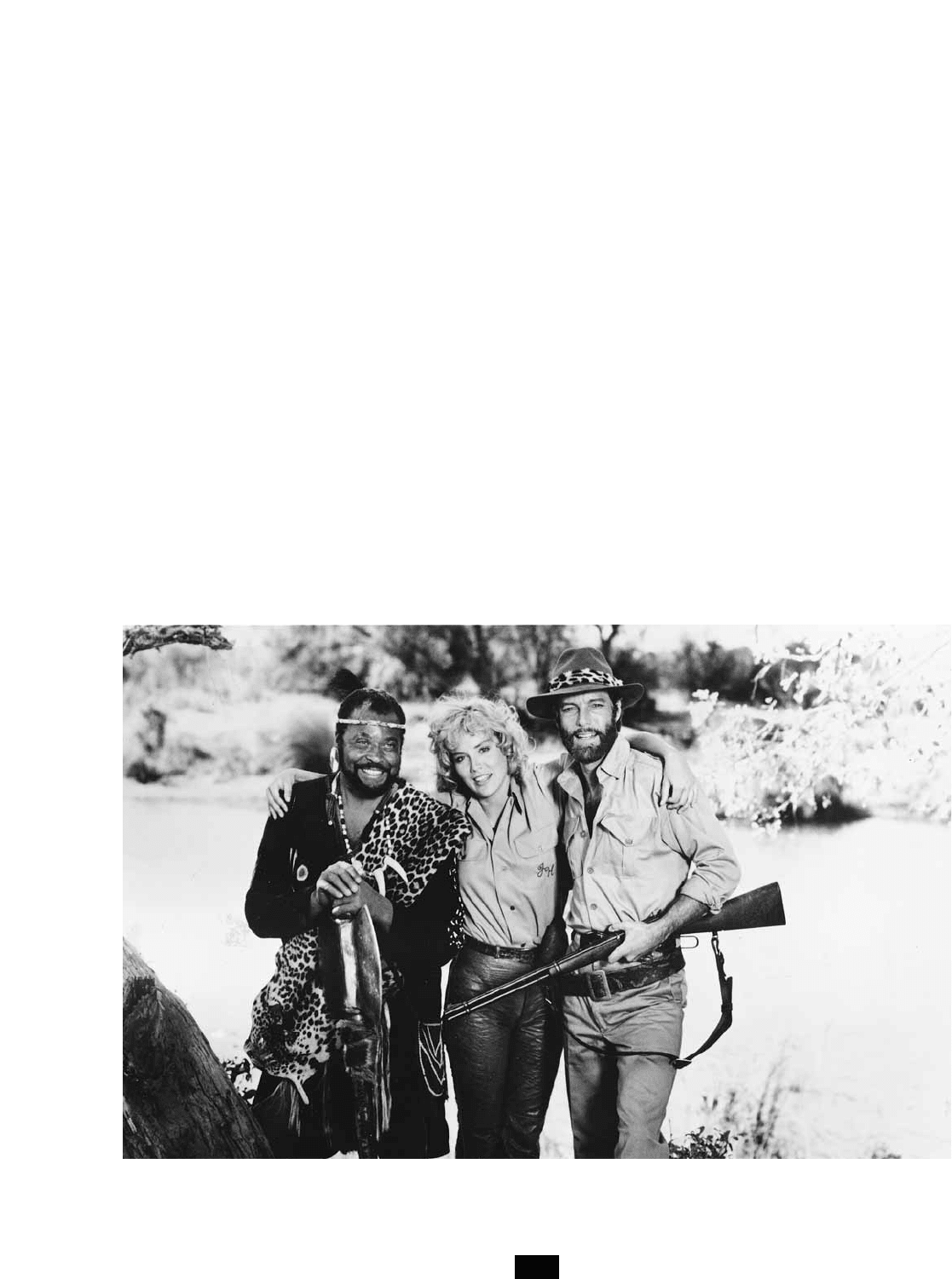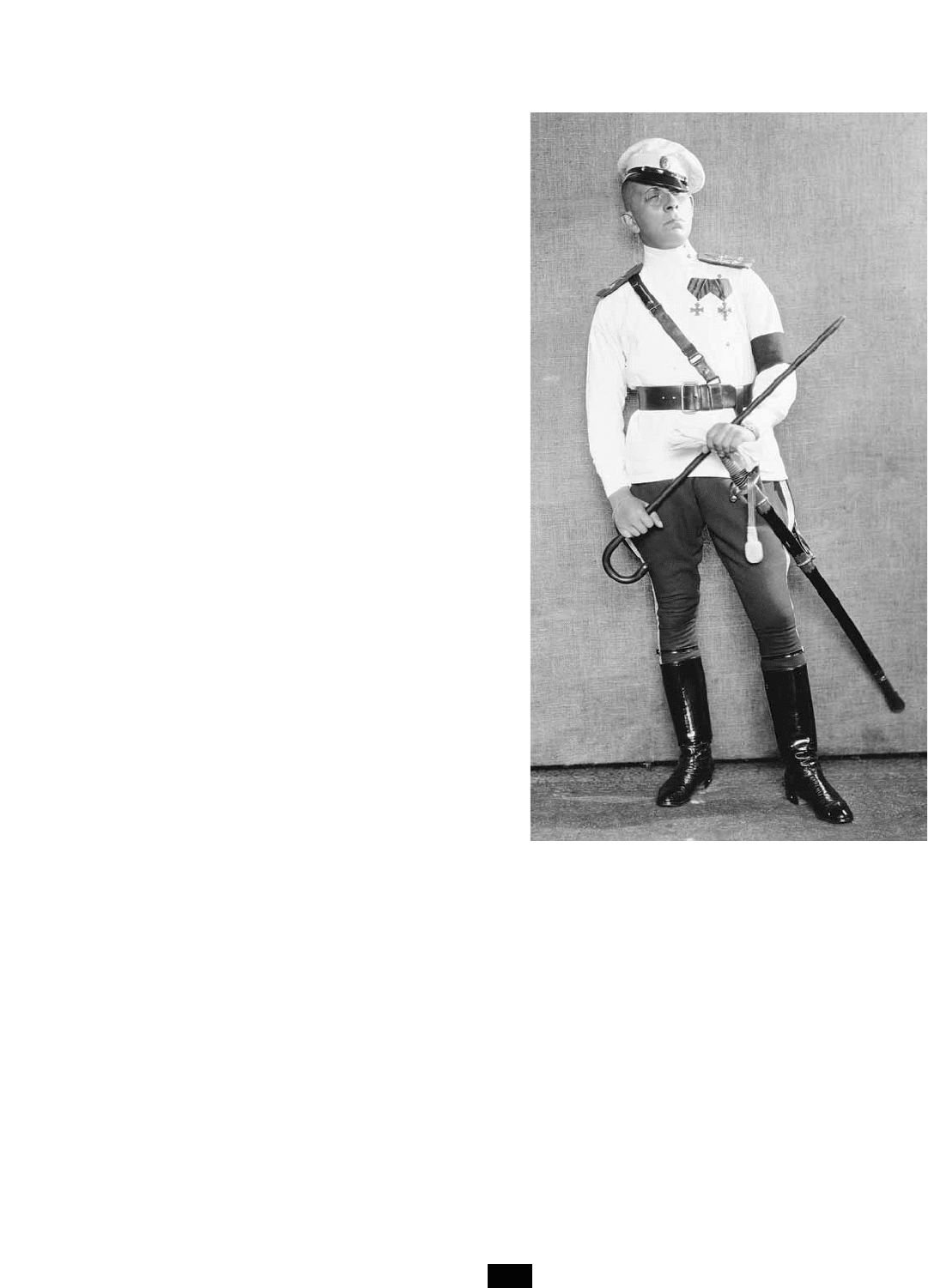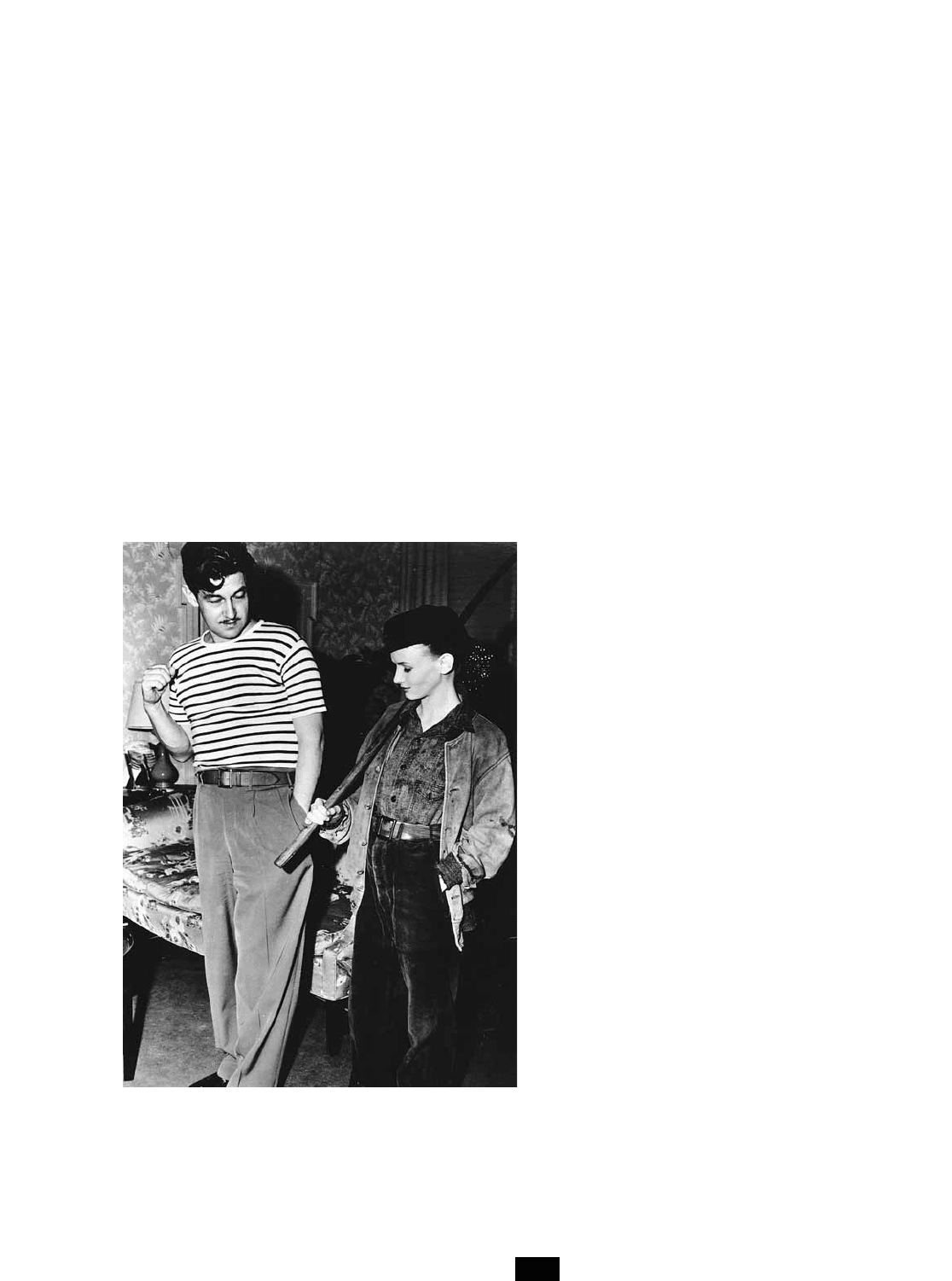Siegel S., Siegel B. The Encyclopedia Of Hollywood
Подождите немного. Документ загружается.


studied method acting with Marilyn Freid and Jack Waltzer.
She then did television commercials for Diet Coke and
Clairol. In her first role, in Stardust Memories, she was cast as
a bimbo who looked like Barbie; and in her second film,
Deadly Blessing (1981), directed by Wes Craven, she played a
drug-addicted model who becomes a stalker’s victim. This
was hardly an auspicious start in film, so she turned to televi-
sion, appearing in Bay City Blues as a baseball player’s wife in
the short-lived series. Her next significant film was Irreconcil-
able Differences (1984), in which she played a waitress, show-
ing some comic talent. Also in 1984, she appeared in two TV
movies, The Vegas Strip Wars, playing a cigarette girl who
seduces
ROCK HUDSON
in his last TV role, and Calendar Girl
Murders, in which she again played the bimbo, this time as a
pinup in a girlie magazine.
She starred in two films after her 1984 marriage to
Michael Greenburg, who as coproducer of King Solomon’s
Mines (1985) and Allen Quatermain and the Lost City of Gold
(1987), cast her in the films. (She split with Greenburg in
1987). The two films did little for her career. She next
appeared in War and Remembrance, a television miniseries
that ran for 30 episodes, and then returned to film. Minor
roles followed: Police Academy 4: Citizens on Patrol (1987), Cold
Steel (1988), Above the Law (1988) with Steven Seagal, and
Action Jackson (1988), in which she played another sexy
woman. In Tears in the Rain (1988), made for British televi-
sion, she had the lead; and she had a small part in Beyond the
Stars (1989), made for American cable TV. She had a larger,
physically demanding role in Total Recall (1990) with
ARNOLD
SCHWARZENEGGER
, playing Schwarzenegger’s dangerous
wife. She posed for Playboy that same year.
Five Stone films appeared in 1991. Two, Diary of a Hitman
and Where Sleeping Dogs Lie, were forgettable, but the other
three showed some promise. In a wannabe Hitchcock film,
Scissors, she played an unstable young woman under siege; in
Year of the Gun, she and costar Andrew McCarthy play lovers
who are threatened by the terrorist Red Brigade in Germany;
and in He Said, She Said, she is excellent as Kevin Bacon’s
nasty ex-girlfriend. In a way, these roles prepared her for the
part she may best be known for, the bisexual novelist Cather-
ine Trammell, the killer pursued, in more ways than one, by
detective
MIKE DOUGLAS
in Basic Instinct (1992). She received
the MTV Movie Award for Best Female Performance and as
Most Desirable Female for her performance. Basic Instinct was
followed in 1993 by Sliver, another voyeuristic thriller, which
resulted in her being nominated for an MTV Most Desirable
Female Award, and Intersection, one of costar
RICHARD GERE
’s
few weak films. In 1994, Stone appeared in two more duds,
each one featuring her as an avenging killer: She plays a
CLINT EASTWOOD
-like role in The Quick and the Dead, and a
STONE, SHARON
408
Sharon Stone in Alan Quatermain and The Lost City of Gold (1987) (AUTHOR’S COLLECTION)

woman intent on killing Cuban gangsters in The Specialist, a
film which costarred
SYLVESTER STALLONE
.
In 1995, she had a wonderful role in Casino, the third in
SCORSESE
’s gangster trilogy. For her role as Ginger, the
hedonistic and materialistic wife of
ROBERT DE NIRO
’s char-
acter, she won a Golden Globe as Best Actress and an Oscar
nomination. Again, Stone had trouble capitalizing on her
success. In 1996, she appeared in the inferior remake of the
1955 French film classic Diabolique, and in Last Dance, she
played an innocent convicted murderer, a part that might
have worked for her if the script had not given her lawyer
(Rob Morrow) most of the attention. Sphere (1997) was for-
gettable, and Gloria (1998) was another bad remake, this one
of
JOHN CASSAVETES
’s 1980 original. She ended the decade
with the eponymous role of Muse, the daughter of the Greek
god Zeus, representing an ideal, much like the 10 (1979)
appearance of Bo Derek, that does not exist in the real world.
Too often, Stone has fallen short of her potential.
storyboard A series of drawings or sketches that indicate
what each successive shot in a scene or sequence should look
like when filmed. Generally, storyboards are made to illus-
trate the action of the most complicated scenes (and there-
fore the ones most expensive to produce) in a film to guide
the director, cinematographer, and cameraman in their par-
ticular tasks.
Some directors rely heavily on storyboards for all sorts of
scenes and shoot only what they’ve prepared in advance,
while others prefer a looser approach, improvising and/or
shooting scenes from several angles, intending to decide on
the final succession of shots in the editing room rather than
before filming.
Of all directors,
ALFRED HITCHCOCK
was the most
famous for relying on storyboards. He was known to plot
every single shot of his films in advance, leaving nothing to
chance. By this method, he was able (to a very great extent)
to avoid studio interference in the recutting of his films. His
thrillers were so efficiently planned that he could film an
entire feature and leave only a miniscule 200 feet of unused
footage after the movie had been edited.
Stradling, Harry (1902–1970) A gifted cinematogra-
pher who had to leave America in 1935 to make his reputa-
tion. When he returned in 1940, he became a leading director
of photography and a two-time Oscar winner. Stradling
worked in all genres but was particularly active in musicals,
which drew heavily on his skill with color photography.
Though born in England, Stradling arrived in the
United States while an adolescent and began to work as a
Hollywood cameraman during the 1920s. There was noth-
ing distinguished about his early career either in the silents
or in the early sound era. Eventually, he left America and
brought his skills to bear on the French production of
Jacques Feyder’s Carnival in Flanders (1935), a film that gar-
nered him his first real attention. He soon traveled to the
land of his birth, providing the clean, crisp photography for
such films as The Divorce of Lady X (1938), Pygmalion (1938),
and The Citadel (1938).
Stradling made a triumphant return to Hollywood in
1940 and was immediately given important film assignments,
such as Hitchcock’s Suspicion (1941), The Human Comedy
(1943), and his first Oscar-winning film, The Picture of Dorian
Gray (1945).
In the latter half of the 1940s, Stradling began his valued
work on MGM musicals where he was responsible for the
rich and vibrant color photography for such films as The
Pirate (1948), Easter Parade (1948), and In the Good Old Sum-
mertime (1949).
During the rest of his career, though putting in work on
such strong black-and-white productions as A Streetcar
Named Desire (1951), and Who’s Afraid of Virginia Woolf?
(1966), Stradling continued his association with the musical.
Among his many credits were Guys and Dolls (1955), The
Pajama Game (1957), My Fair Lady (1964) for which he won
his second Academy Award, Funny Girl (1968), Hello, Dolly!
(1969), and On a Clear Day You Can See Forever (1970). These
last three starred
BARBRA STREISAND
, and Stradling was
working on a fourth with the star, The Owl and the Pussycat
(1970), when he died.
Stradling’s son, Harry Stradling Jr. (1925– ), also
became a cinematographer. He has worked consistently since
the late 1960s, showing flashes of brilliant color photography
in such films as Little Big Man (1970), The Way We Were
(1973), Bite the Bullet (1975), Go Tell the Spartans (1978), The
Pursuit of D. B. Cooper (1981), and Micki & Maude (1984). He
has also worked in television, providing the cinematography
for the 1984 miniseries George Washington.
Streep, Meryl (1951– ) The premier movie actress of
the 1980s, whose performances have often outshined her
films, even while many of her vehicles have been top-notch,
thoughtful entertainments. An elegant beauty, the oft-times
Oscar nominated Streep has become known for her remark-
ably accurate accents, playing characters from Scandinavia,
the American Deep South, Poland, and Australia. Her acting
talent, however, goes far beyond her skill with accents; she
thoroughly absorbs herself in her roles as does no other
actress of our time.
Born Mary Louise Streep to a well-to-do New Jersey
family, she first wanted to pursue a career in the opera. A few
years later when she was in high school, Streep’s passion
turned to acting. She studied drama at Vassar and went on to
the famous Yale Drama School for an advanced degree. Her
ascent was swift after that. Streep moved from the Yale
Repertory Company to Broadway and soon won a Tony
nomination for her performance in Tennessee Williams’s 27
Wagons Full of Cotton.
Streep made the leap from stage to both the small and the
big screen in 1977 with a lead role in a TV movie The Dead-
liest Season and a small supporting role in the acclaimed
motion picture Julia. The following year, though, she made a
much bigger impact in both media, taking home an Emmy for
her performance in the acclaimed miniseries Holocaust (1978)
STREEP, MERYL
409

and garnering a Best Supporting Actress Oscar nomination
for the Academy Award-winning The Deer Hunter (1978).
Television was left behind for the movies as Streep went
on to play the modest role of
WOODY ALLEN
’s ex-wife in
Manhattan (1979) and the bright southern belle temptress of
Alan Alda in The Seduction of Joe Tynan (1979). Critics were
already buzzing about Streep and telling movie fans to keep
their eye on her.
At the end of 1979, she played
DUSTIN HOFFMAN
’s wife in
Kramer vs. Kramer (1979) and walked away with a Best Sup-
porting Actress Oscar. She hasn’t had a supporting part since.
She has starred in a wide variety of roles, showing a versatility
unmatched by any film actress save
BETTE DAVIS
. From her
dual role in The French Lieutenant’s Woman (1981) as a movie
actress and the character she plays to her Oscar-winning per-
formance as the tortured Polish immigrant in Sophie’s Choice
(1981), and from the complex and troubled title character in
Silkwood (1983) to an alcoholic old crone who loves her man
in Ironweed (1987), she has electrified audiences with a unique
combination of subtlety and bravura. Her starring perform-
ance (opposite Roseanne Barr) in She-Devil (1989), a broad
comedy turn, is yet another example of Streep’s wide-ranging
skills and her willingness to take chances.
Despite her consistently good notices, Streep has not
always surfaced in either critical or commercial hits. The
mystery thriller Still of the Night (1982) was a disappoint-
ment, as were the modern love story Falling in Love (1984)
and the modern divorce story Heartburn (1986). Often,
though, critics have liked her films more than the general
public, as was the case with Ironweed (1987) and A Cry in the
Dark (1988), both of which won her Oscar nominations.
Audiences flocked to see her in the Oscar-winning Out of
Africa (1985) however, despite the film’s decidedly mixed
reviews. Although Streep has not become a major box-office
draw, audiences have come to expect that any film she stars in
will be a quality production.
During the 1990s, she continued to garner Oscar nomi-
nations (four) and critical acclaim as she demonstrated her
comedic and dramatic skills, and she again took on a wide
variety of roles: She was the alcoholic wannabe actress
attempting to cope with a domineering mother (played by
SHIRLEY MACLAINE
) in Postcards from the Edge (1990); a mus-
cular white-water-rafter action heroine in The River Wild
(1994); an isolated, frustrated, frumpy farm wife in Iowa who
consents to a brief but torrid romantic affair with
CLINT
EASTWOOD
in The Bridges of Madison County (1995); and the
clairvoyant wife of Jeremy Irons in Allende’s The House of the
Spirits (1993). Streep was featured as an Irish spinster, with an
on-target brogue, in Dancing at Lughnasa (1998), adapted
from the fine Irish play by Brian Friel, and played the lead in
Music of the Heart (1999), the story of an altruistic violin
teacher in Harlem, this last resulting again in Golden Globe
and Oscar nominations. In
STEVEN SPIELBERG
’s A.I. (2001),
Streep did the voice of the Blue Fairy. Because she often
appears in the film adaptations of quality literary sources, it
was perhaps inevitable that she would appear in the film treat-
ing novelist Virginia Woolf, The Hours (2002); she was nomi-
nated for a Golden Globe for her performance. That same
year she received plaudits for her work opposite
NICOLAS
CAGE
in the intellectually challenging Adaptation, as a tor-
mented author with a secret that would be so damaging that
she is willing to attempt murder to protect her reputation.
Streisand, Barbra (1942– ) A singer, actress, direc-
tor, producer, and songwriter who has become one of the
biggest female box-office draws of the last two decades. Her
big nose, heavy Brooklyn accent, and alleged “difficult” tem-
perament have not stood in the way of her talent. Streisand’s
soaring singing voice has been her claim to fame, but she has
also proved to be a powerful dramatic actress as well as a
gifted comedienne. Her talents have been appreciated almost
from the very start of her professional career and in almost
every medium. She was nominated for a Tony for her very
first Broadway play, I Can Get It for You Wholesale in 1962,
won a Grammy for her first album, won an Emmy for her
first TV special, and won an Oscar for her first film, Funny
Girl (1968), which she shared with the legendary
KATHARINE
HEPBURN
due to a tie vote.
Born Barbara Joan Streisand in Brooklyn, New York, she
later dropped the second a from her first name to set herself
apart. When she was 10 years old, she decided to try for a
record contract and traveled across the East River to sing for
a recording company—and was turned down. According to
Jonathan Black in Streisand, after this “rejection,” she con-
centrated more on an acting career. Streisand did not seri-
ously consider singing as an option because it simply came
too easy to her.
After high school, she took acting lessons but made little
progress until she began to sing for extra money at a gay bar
in Greenwich Village. It was her singing career that contin-
ued to thrive and opened doors for her, getting her a sup-
porting role in I Can Get It for You Wholesale, which had
originally been written for a woman more than twice her age.
It was during the run of that play that she met and married
the show’s star, Elliott Gould.
Her success as a recording and nightclub artist led to her
being cast as Fanny Brice in the Broadway musical Funny Girl
in 1964; she was a critical and commercial sensation.
Streisand went on to reprise her role in her hit film debut and
became an overnight movie star. She has since starred in a
dozen other films.
During the late 1960s and throughout the 1970s, she
starred in nearly a film every year on average, beginning with
two disappointing musical bombs, Hello, Dolly! (1969) and On
a Clear Day You Can See Forever (1970), but she recouped
smartly in the nonsinging romantic-comedy lead in The Owl
and the Pussycat (1970) and scored more raves and big box
office with
PETER BOGDANOVICH
’s ode to the screwball com-
edy, What’s Up Doc? (1972). Up the Sandbox (1972) was a more
strident comedy and therefore received mixed reviews and did
mediocre business. But Streisand did what many considered
the impossible, starring in a credible romantic love story with
ROBERT REDFORD
in The Way We Were (1973). The film was
adored by both the critics and movie fans, becoming a major
hit (as was the theme song, recorded by Streisand).
STREISAND, BARBRA
410

Her films during the rest of the 1970s were, at best,
mediocre. The comedies For Pete’s Sake (1974) and The Main
Event (1979) didn’t generate a great deal of enthusiasm. Her
musicals, the sequel to Funny Girl, Funny Lady (1975), and a
remake of A Star Is Born (1976) were commercial successes
despite generally poor to mixed reviews.
Streisand was increasingly depicted during the 1970s as a
temperamental perfectionist, a performer impossible to
please who made life on the set unbearable. She rebutted that
no one cared about the quality of her films more than she did
and that everyone else was looking for the easy way out. As a
result, she became more and more involved in her own pro-
ductions. For instance, she composed “Evergreen” with Paul
Williams for A Star Is Born and won an Oscar for Best Song.
She went on to become co-executive producer of The Main
Event, and after a four-year absence from the big screen she
cowrote, produced, directed, and starred in the musical, Yentl
(1983). Although the reviews were mixed, audiences had no
reservations; the film was a major hit, and many expected it
to be a big contender at the Academy Awards. To the aston-
ishment of Streisand fans and many independent observers,
she was overlooked as both an actress and a director.
Snubbed by Hollywood, she again disappeared from the
big screen until she returned in the intense drama Nuts
(1987) and was again denied an Oscar nomination to the dis-
may of her legion of fans.
In 1991, Barbra Streisand starred opposite Nick Nolte in
The Prince of Tides, which she also directed. The film concerns
the relationship between psychiatrist Streisand and her
patient Tom Wingo, played by Nolte. The film, adapted from
Pat Conroy’s novel, won a Golden Globe Award as Best Actor
for Nolte, though Streisand’s acting and directing efforts were
ignored. It would be five more years before Streisand would
again star in and direct a film. The Mirror Has Two Faces (1996)
cast her opposite Jeff Bridges and in conflict with her mother,
played by
LAUREN BACALL
. Though Bacall attracted most of
the critical attention and won a Golden Globe for Best Sup-
porting Actress, Streisand also won a Golden Globe for Best
Actress in a Musical or Comedy.
Stroheim, Erich Von (1885–1957) A director, actor,
screenwriter, set designer, costume designer, and notorious
spendthrift, he was reputed to be the most extravagant artist
in Hollywood, having spent enormous amounts attending to
the minutest details in his movies (such as historically accu-
rate underwear worn by soldiers in Foolish Wives, 1922). His
saving grace as a director, however, was his extravagance of
talent, enabling him to grace his films with a strong visual
flair that few other silent-film directors could match. Von
Stroheim was also a talented, if limited, actor who specialized
in playing arrogant Prussian military types.
He claimed that he was born Erich Oswald Hans Carl
Stroheim von Nordenwald, but his background was not quite
as blue-blooded as he purported. He was, nonetheless, the
son of a former officer in the Austrian army who had squan-
dered his wife’s inheritance in bad business deals. The family
lived well, thanks only to the charity of von Stroheim’s uncle,
who held a high position in the government. Von Stroheim,
himself, was a lieutenant in the Austrian army and saw three
months of active duty in World War I before being forced to
resign his commission due to his wild spending and inability
to pay his debts. (Von Stroheim’s profligacy with money evi-
dently was a problem long before he began to make movies.)
His uncle offered to pay the young man’s debts on condition
that von Stroheim be banished to America.
Von Stroheim arrived in New York when he was 24 years
old. He had no skills except as a soldier and a gentleman,
STROHEIM, ERICH VON
411
Erich Von Stroheim became “The Man You Love to Hate”
by playing autocratic Prussian officers in films from World
War I to the 1950s. His lasting fame, however, came as a
director during the silent era when he made a series of
elaborate and expensive movies.
(PHOTO COURTESY OF
THE SIEGEL COLLECTION)

which promptly landed him a succession of jobs that included
wrapping packages at a department store, selling dresses,
working as a handyman, and hitting the road as a flypaper
salesman. He had little luck in his early years in America, but
his short-lived marriage to a wealthy suffragette, Dr. Mar-
garet Knox, was instrumental in giving von Stroheim the
tools he needed to help himself. She improved his use of
English and renewed his confidence.
After the marriage ended, von Stroheim put on a one-act
play in Los Angeles that failed miserably, but one of his actors
suggested that he try to get into the movies, and he did, wan-
dering over to the location where
D
.
W
.
GRIFFITH
was shoot-
ing
THE BIRTH OF A NATION
(1915). Von Stroheim picked up
a job as a stuntman/extra and can be seen in his movie debut
as a black soldier who is hit by a bullet on a rooftop and falls
18 feet to the ground.
He went on to become one of Griffith’s assistant directors
on Intolerance (1916) and during World War I built his acting
career by playing tyrannical Prussian officers. By the time he
appeared in Griffith’s Hearts of the World (1918), he was billed
as “The Man You Love to Hate.”
On the strength of his new image and growing experience
in the film business, he talked
CARL LAEMMLE
of
UNIVERSAL
PICTURES
into bankrolling his story idea for Blind Husbands
(1918), telling the film executive it would cost $10,000 to
make the movie if von Stroheim could both direct and star in
it. Final production costs were almost $100,000, but the
movie was a hit and easily earned back its expenses.
Now a director of note, von Stroheim went on to make
The Devil’s Passkey (1919), Foolish Wives (1921), and Merry-
Go-Round (1922), all of which were roundly praised for their
attention to detail, strong visual sense, and sophisticated
content. By this time, von Stroheim was deeply involved in
every aspect of his films: writing the scripts, designing the
sets, costuming the actors, directing, and finally editing his
films. But he rarely had the last edit because his movies were
far too long. For instance, Foolish Wives was originally 32
reels in length. It was finally edited down to a 14-reel feature
by the studio.
But that was nothing compared to Greed (1924), the film
for which von Stroheim became famous. Based on Frank
Norris’s novel, McTeague, von Stroheim’s film ballooned into
a 42-reel epic that would have run nearly eight hours. He cut
it to 24 reels but would make no further edits himself. Direc-
tor Rex Ingram cut it to 18 reels, and it was later released by
MGM in a somewhat confusing 10-reel version. Even so, the
film’s power was overwhelming. Unfortunately, the movie
cost $750,000 to make, and it barely broke even. Some who
saw the original version of this tale of avarice called it the
cinema’s greatest masterpiece. There are those who say that
the original footage still exists in the deep recesses of an
MGM vault.
Greed, which starred
ZASU PITTS
and
JEAN HERSHOLT
,
chronicled the disintegration of human values caused by the
lust for wealth. Certain sequences in the film were tinted yel-
low (to represent gold), and the movie’s climax was shot dur-
ing the summer in Death Valley—for both the realistic effect
it had on the actors and for its symbolic overtones.
Based on the critical success of Greed, von Stroheim was
allowed to direct another movie at MGM, although this time
under strict limitations. He made The Merry Widow (1925), a
critical and commercial success, and then The Wedding March
(1928) and The Honeymoon (1928, in Europe; it was never
released in the United States), which were actually two halves
of the same film.
No one denied von Stroheim’s ability as a director, but he
simply was becoming too expensive to employ. He took too
long to make his films, and their budgets were staggering.
Just the same, Gloria Swanson sought him out. She was seek-
ing a sophisticated continental touch for her independently
produced film Queen Kelly (1928). Her timing was terrible;
just as sound was coming into vogue, von Stroheim spent a
staggering $600,000 on a silent film. Swanson fired him and
then spent another $200,000 of her own money to salvage the
movie, but Queen Kelly became a major financial disaster.
His directorial career a shambles as the silent era ended,
von Stroheim spent the rest of his life working as an actor,
hoping to someday direct again. He starred as a ventriloquist
in The Great Gabbo (1929) and as a mad movie director in The
Lost Squadron (1932), being well received in these early films.
But he soon became typecast as the officious Prussian soldier
in both American and European productions such as Grand
Illusion (1937) and Five Graves to Cairo (1943). He also was
involved in the writing of screenplays for a number of
movies, including The Emperor’s Candlesticks (1936) and The
Devil Doll (1936).
But von Stroheim never directed again. In a final irony, he
played a former silent film director reduced to being a chauf-
feur for the once-great silent screen actress Norma Desmond
(played by Gloria Swanson) in Sunset Boulevard (1950).
Von Stroheim made his last film appearance in the
French film La Madone des Sleepings (1955). The complex and
fascinating von Stroheim died two years later in Paris.
See also
SWANSON
,
GLORIA
.
studio system A term that refers to the institutionalized
commercial and artistic practices that governed the American
film industry between the years 1930 and 1949. During this
two-decade period, the film industry was consolidated into
eight major companies, known within the film community as
the Big Five and the Little Three. The Big Five included
WARNER BROS
., Paramount, MGM, RKO, and
TWENTIETH
CENTURY
–
FOX
. The Little Three were Universal,
UNITED
ARTISTS
, and Columbia. Constituting a monopoly, these
eight companies were able to establish a homogeneous sys-
tem—the studio system—that controlled how films were
made, who made them, who starred in them, and what the
content of those films would be.
THOMAS EDISON
, the inventor of the motion picture,
made a bold attempt to monopolize the film industry during
the second decade of the 20th century, but the eight major
film companies that emerged out of the talkie revolution suc-
ceeded where Edison failed.
The Big Five were fully integrated companies, control-
ling all aspects of the film industry within their corporate
STUDIO SYSTEM
412

organization, including the creation, distribution, and exhibi-
tion of their own films. The Little Three had modest impact
in the area of exhibition (e.g., they either didn’t own any the-
aters or owned relatively few, but they all had strong, inter-
national distribution networks).
The Big Five owned the most prestigious theaters, in the
best locations, in the most populous areas of the country,
skimming off the greatest percentage of profits. According to
Douglas Gomery in his informative book, The Hollywood Stu-
dio System, the Big Five controlled “approximately 25 percent
of the total seats in U.S. theaters. Collectively, the majors
controlled more than 70 percent of all the first-run theaters
in the ninety-two largest cities in the U.S.”
Owning theaters was the ultimate key to success during
the studio system years. Being a fully integrated company vir-
tually guaranteed success as long as audiences continued
going to the movies because the eight majors were the only
game in town. In fact, the Big Five, in true monopolistic fash-
ion, all profited when any one of the studios had a hit. The
reason for this was the generally unknown fact that the stu-
dios didn’t directly compete against each other in terms of
exhibition; they each owned most of their theaters in differ-
ent areas of the country and, therefore, if one studio had a
hit, it was rented to their competitors in other parts of the
country and both parties split the profits. It was a no-lose sit-
uation, except in instances where the producing company
made a film that no one wanted to see. But even those films
were guaranteed significant distribution within the theater
circuits owned by their own studio and the hungry inde-
pendent rural and small neighborhood theaters that
depended on the eight majors to supply them with product.
Borrowing from the Henry Ford method of building
automobiles, the studio system employed an assembly-line
approach to filmmaking. Rigidly compartmentalized, the film
studios made popular art by organizing their creative staffs
(writers, directors, actors, etc.) to move from one movie to
the next without being fully involved with the entire process.
Films were often treated as product rather than personal
visions because there was rarely one person who could infuse
his or her personality into a project from start to finish.
The personalities who ultimately dominated during the
years of the studio system were the movie moguls whose
tastes and attitudes were reflected in the films that they made.
For instance,
DARRYL F
.
ZANUCK
, head of production at
Twentieth Century–Fox, was a liberal with a social con-
science, which was evident by his productions of such films as
Gentlemen’s Agreement (1947) and Pinky (1949).
The moguls, men like
JACK L
.
WARNER
,
HARRY COHN
,
and
LOUIS B
.
MAYER
, ran their studios as if they were emper-
ors—and to some extent they were. For example, the most
infamous aspect of the studio system was the long-term serv-
ice contract (usually seven years) by which actors were often
bound as if they were indentured servants to their studio,
working at salaries far below their worth.
ROBERT TAYLOR
,
for instance, was starring in major motion pictures during the
early part of his career while earning a paltry $35 per week.
Besides the issue of salary, the moguls also declared who
would appear in what movie, often forcing actors to perform
in films they thought were atrocious and/or bad for their
careers. There were a number of celebrated cases of stars,
such as
BETTE DAVIS
and
JAMES CAGNEY
, going on suspen-
sion rather than act in movies they hated.
The end of the studio system came when the Big Five
were forced by the government, in an antitrust action in
1949, to sell their theaters, depriving them of their guaran-
teed exhibition network as well as their greatest real estate
assets. Independent filmmakers could finally get significant
distribution and exhibition, opening the door to genuine
competition. Stars began to set up their own production
companies, using the studios to produce and distribute their
films but controlling their own projects. Wounded and no
longer a true monopoly, the studio system was finally done in
by television, which siphoned off millions of viewers during
the 1950s.
Ironically, for all the complaints aimed at the studio sys-
tem, it was during this era that Hollywood made the vast
majority of its greatest films, and many—even those who suf-
fered through it—look back at those times with great fondness.
stuntmen The men and women who perform dangerous
physical feats in motion pictures (usually doubling for
actors). During the early silent era, before actors became
highly paid stars, performers almost always had to perform
their own stunts. Later, as stars became valuable commodi-
ties, studios sought to avoid risking actors’ health and good
looks and hired stuntmen to undertake perilous tasks in the
stars’ place. Theirs was not, however, a highly regarded pro-
fession. As stunt flyer Dick Grace wrote in his 1930 memoir,
The Squadron of Death, “The stars think the stuntman is just
a little above an extra. The producers think he is a little below
a moron. The public has never heard of him.”
Stunts and stuntmen may be in constant use in today’s
films, but there was a veritable stunt craze in the 1920s.
BUSTER KEATON
,
HAROLD LLOYD
, and
DOUGLAS FAIR
-
BANKS
set a standard for their own elaborate stuntwork,
while other stars happily allowed stuntmen to double for
them. A number of stuntmen were killed and injured during
this era. Among the earlier stuntmen of this time period were
“Suicide” Buddy Mason, Eddie Polo, and Richard Talmadge.
The first female stuntperson was Helen Gibson, who later
became a star (of serials) in her own right.
YAKIMA CANUTT
, the most famous stuntman of them all,
pioneered safer stuntwork during the 1930s. As a result of his
efforts and the exploits of many others, stunt people gained a
certain grudging respect from directors, stars, and producers.
Stuntwork in the 1930s and 1940s was part and parcel of
aviation films, gangster movies, war films, and westerns. But
in the 1950s and early 1960s, as epics came into vogue, the
stuntmen became ever more important in films such as Ivan-
hoe (1952), Ben-Hur (1959), and Spartacus (1960). Later, in
the car crash era of Bullitt (1968) and The French Connection
(1971), yet a new need for experienced stuntmen arose.
Movie stunts have become so elaborate and have drawn
so much attention in recent decades with films such as The
Blues Brothers (1980) and Raiders of the Lost Ark (1981) that
STUNTMEN
413

the stuntman has finally been recognized by the public as a
significant movie professional. It is no coincidence, therefore,
that Hal Needham (a former stuntman himself) directed a hit
film about stuntmen called Hooper (1978), and Richard Rush
finally found distribution for his highly regarded Oscar-nom-
inated film The Stunt Man (1980).
As a general rule, most stuntmen specialize in areas as
diverse as motorcycles, antique planes, high falls from build-
ings, fire, and horse falls. They are paid on the basis of the
difficulty and risk of danger involved in their stunts. The
Hollywood Stuntmen Association represents the roughly 100
fearless specialists in this close-knit community.
Sturges, Preston (1898–1959) He was the comedy
writer-director of the 1940s despite the fact that all of his
good work was done in the first half of the decade. His
scripts were famous for their snappy repartee and his films
for a frantic, almost breathless, pace that never let up.
Sturges’s humor could be savagely satirical, usually under-
cutting Hollywood conventions and expectations. If the
director sometimes lacked the courage of his convictions and
often gave his satires illogical happy endings, the mighty
leaps of craft required to arrive at these rose-colored cli-
maxes were often so ingenious that they, too, brought laugh-
ter and delight.
Born Edmond P. Biden to an extremely wealthy Ameri-
can family, he was largely educated abroad in France,
Switzerland, and Germany. Both before and after serving a
volunteer stint as a flyer in the army air corps during World
War I, he worked for his mother’s cosmetics company, where
he invented a kiss-proof lipstick. Like
HOWARD HUGHES
,
Sturges was a tinkerer, an inventor, and an airplane nut, and,
like Hughes, he was drawn to the movies.
While recuperating from an operation to remove his
appendix, this 20th-century renaissance man wrote several
plays, one of which became the 1929 Broadway hit comedy
Strictly Dishonorable, later turning up in two movie versions,
the first in 1931 and the second in 1951. Sturges’s quick wit
and colorful language were ideal for the movies and he was
soon writing dialogue for such films as The Big Pond (1930)
and Fast and Loose (1930). As the 1930s progressed, he created
original screenplays for films including The Power and the
Glory (1933), Diamond Jim (1935), Easy Living (1937), If I
Were King (1938), and Remember the Night (1940).
Unhappy with the way his screenplays were being
directed, however, Sturges appealed to Paramount to let him
direct his own work. Up until then, the studios held to a strict
division between writers and directors. But Paramount, tra-
ditionally one of the more liberal studios, gave Sturges his
chance, leading the way for future writer-directors of the cal-
iber for
JOHN HUSTON
and
BILLY WILDER
.
Sturges’s debut as a writer-director was The Great
McGinty (1940), the sleeper hit of the year. It satirized Amer-
ican politics by presenting a hobo turned governor, who
makes it to the top through graft and corruption, only to fall
from grace when he turns honest. It was
FRANK CAPRA
gone
haywire, and audiences loved it. So did the critics. The
Academy of Motion Picture Arts and Sciences rewarded
Sturges with a Best Screenplay Oscar for his iconoclastic
effort.
Sturges followed that auspicious beginning with a stun-
ning string of six more witty and piercing comedy hits. All of
them poked fun at some aspect of society: advertising and
American gullibility in Christmas in July (1940), intellectual
snobbery in The Lady Eve (1941), pretentiousness in Holly-
wood in Sullivan’s Travels (1941), marriage and sex in The
Palm Beach Story (1942), small-town Americana and sex in
The Miracle of Morgan’s Creek (1944), and momism and hero
worship in Hail the Conquering Hero (1944).
Sturges’s films were identifiable not only from their rat-
a-tat verbal style and clever content but also from his choice
of actors. There was an informal Sturges stock company of
performers who consistently showed up in his movies, most
notably William Demarest, Franklin Pangborn, Jimmy Con-
lin, Robert Greig, Edgar Kennedy, and Eric Blore.
As quickly as he emerged on the directorial scene, Sturges
submerged even faster. After the turgid The Great Moment
STURGES, PRESTON
414
Writer-director Preston Sturges is seen here instructing
Veronica Lake for her role in Sullivan’s Travels (1941), which
also starred Joel McCrea. The film was just one of Sturges’s
remarkable string of satiric comedy hits during the first half
of the 1940s.
(PHOTO COURTESY OF MOVIE STAR NEWS)

(1944), he agreed to make movies in association with Howard
Hughes, whom he so resembled. The arrangement proved
unworkable, and Sturges limped through the next few years
writing, directing, and producing movies that lacked the spark
of his previous work. The best of those films was the ambi-
tious but flawed Mad Wednesday (1947), a movie designed to
resurrect the comedy career of silent-screen great
HAROLD
LLOYD
but which flopped at the box office. Unfaithfully Yours
(1948) followed, and then The Beautiful Blonde From Bashful
Bend (1949), neither proving to be major successes, although
the former was a modest hit (remade in 1984 with
DUDLEY
MOORE
in the Rex Harrison role).
Sturges had had enough of Hughes by the end of the
1940s and removed himself to Europe, where he eventually
made his last movie, the pallid The French They Are a Funny
Race (1955). He died shortly thereafter.
See also
WRITER
-
DIRECTORS
.
subjective camera Otherwise known as a “point of view”
(or POV) shot, the camera technique which allows audiences
to see a film’s action as though through the eyes of one of its
characters and not from the impersonal vantage point of a
merely observant camera angle.
The language of film easily allows for a flow between the
omniscient point of view and the subjective camera, and most
films are filled with a great many short, subjective camera
shots. For instance, if a character in a gangster film must
reach for a gun on the floor, the camera may catch the char-
acter surreptitiously glancing downward and then cut to the
gun (from the hero’s POV) as it lies underneath a table.
Less common are long, subjective camera scenes, but one
of the most memorable occurs in the
JERRY LEWIS
comedy
The Nutty Professor (1963). In this film, Lewis plays a Jekyll-
and-Hyde character who alternates between nerdy professor
and hip swinger, Buddy Love. When the transformation
occurs a subjective camera angle takes over for several min-
utes of screen time. While the camera/Lewis/Love “walks”
through the streets to a nightclub, characters turn and gawk
right into the lens (i.e., at the audience).
Subjective camera was used almost exclusively in Dark
Passage (1947) and entirely in Lady in the Lake (1946). In Dark
Passage, directed by Delmar Daves,
HUMPHREY BOGART
is
swathed in bandages after his face is changed through plastic
surgery. The audience sees most of the film through the eye
holes in his bandages until the bandages finally come off near
the end of the movie.
ROBERT MONTGOMERY
, who both
directed and starred in Lady in the Lake, shot the entire film
through the eyes of the movie’s hero, Philip Marlowe. Mont-
gomery was only seen when the hero looked in a mirror.
Montgomery’s film technique was the visual equivalent of the
first person narrative in literature.
Sundance In 1961
ROBERT REDFORD
bought a two-acre
patch of land in Utah for $500, built a log cabin, and eventu-
ally called it “Sundance,” for his role in Butch Cassidy and the
Sundance Kid (1968). Those two acres grew to what is today
25,000 acres of protected land. The Sundance Institute came
into being in 1981 to encourage creativity and imagination
outside the commercial Hollywood sphere. The idea was to
provide a shelter where filmmakers and playwrights could
hone their storytelling skills. It was an idea whose time had
come. El Norte (1981) was one of the first films to come out
of Sundance. It was a humanistic story about immigrants
from Central America seeking a better life in the United
States, and it was a success. Others have followed.
Over time Sundance evolved into a ski resort, though
resort planning was not Redford’s initial intent. According to
Redford, Sundance was “never meant to be a place for finan-
cial gain as much as for the presentation of ideas,” but, as
Redford explained to Town & Country magazine (November
2002), “There needed to be some kind of development—oth-
erwise, I couldn’t pay for it. The center of the enterprise
would be nonprofit; the surroundings would be the revenue-
producing part.”
Sundance has become most famous, however, for the
Sundance Film Festival, held not on the grounds of the Sun-
dance compound but in nearby Park City. “By 1984,” Red-
ford explained, “I realized that independent filmmakers
needed a place to show their work.” The first film made
famous by the Sundance Festival, which starts, traditionally,
during the second half of January, was sex, lies, and videotape,
in 1989. “Then the merchants came, then the stars, the fash-
ion. I have to admit,” Redford said, “it was great fun, but also
ironic,” since, “after all, I came here to get away from Holly-
wood, and now Hollywood was coming to me.”
In 1996 the Sundance Channel made its debut on cable
television, in tandem with
UNIVERSAL STUDIOS
and Show-
time Networks, Inc., and the Sundance Festival has now
become a major outlet for independent films and talent, and
Hollywood has taken notice.
Surtees, Robert (1906–1985) and Bruce (1937– )
Father and son cinematographers, respectively, who have
each developed reputations as experts in their field.
Robert Surtees served his apprenticeship under one of
the greatest of all cinematographers,
GREGG TOLAND
, even-
tually becoming a master of color photography. He first
began to work in Hollywood in 1927, emerging as a full-
fledged director of photography in the mid-1940s with such
films as Thirty Seconds Over Tokyo (1944) and Our Vines Have
Tender Grapes (1945). His ability with color cinematography
was duly noticed by the Academy of Motion Picture Arts and
Sciences in 1950 when he was awarded an Oscar for his work
on King Solomon’s Mines (1950). He would eventually receive
two more Oscars, one each for The Bad and the Beautiful
(1952) and Ben-Hur (1959).
After his triumph with Ben-Hur, Surtees was often
assigned other big-budget movies, such as Mutiny on the
Bounty (1962) and Doctor Doolittle (1967), but his best work
during the 1960s and 1970s was done for smaller movies with
relatively inexperienced directors who gave him more latitude
to create a unique visual style. For instance, he was the cine-
matographer for
MIKE NICHOLS
’s smash hit The Graduate
SURTEES, ROBERT AND BRUCE
415

(1967) and
PETER BOGDANOVICH
’s black-and-white master-
piece The Last Picture Show (1971).
Ever dependable and proficient at his craft, Surtees con-
tinued to work well into the 1970s, providing the cinematog-
raphy for major motion pictures such as The Sting (1973), A
Star Is Born (1976), The Turning Point (1977), and Same Time,
Next Year (1978).
Meanwhile, Robert’s son, Bruce, followed in his father’s
footsteps, becoming a much-admired cinematographer of
action films, his career closely associated with that of
CLINT
EASTWOOD
. Roughly one-third of his films have either
starred Eastwood and/or were directed by the actor. The
younger Surtees began his career providing the cinematog-
raphy for one of Eastwood’s more famous films, Dirty Harry
(1971), as well as the actor’s directorial debut, Play Misty For
Me (1971). Other collaborations with Eastwood have
included High Plains Drifter (1972), The Outlaw Josey Wales
(1976), Escape From Alcatraz (1979), Firefox (1982), Sudden
Impact (1983), Honky Tonk Man (1983), Tightrope (1984), and
Pale Rider (1985).
Although Bruce Surtees was justifiably given an Oscar for
his cinematography for Lenny (1974), one of his greatest
unsung achievements was his work on John Milius’s underap-
preciated masterpiece Big Wednesday (1978). In addition, Sur-
tees has lent his considerable skills to a number of visually
adventurous films such as Night Moves (1975), Leadbelly
(1976), and White Dog (1982). He was also the cinematogra-
pher of such blockbuster hits as Risky Business (1983) and Bev-
erly Hills Cop (1984). His more recent work includes the kindly
reviewed Back to the Beach (1987) and License to Drive (1988).
Sutherland, Donald (1934– ) A hard-working actor
who popped up in roles small and large in a great many
movies, particularly during the 1970s. Tall and gaunt,
Sutherland is hardly the leading man type; yet, his relatively
plain features have kept him from being typecast, and he has
played leads in a number of important movies, showing a
depth of talent and sensitivity.
Born and raised in Canada, Sutherland’s first brush with
show business came when he worked as a D.J. for a Nova
Scotia radio station at age 14. He began to act while attend-
ing the University of Toronto and continued to learn his craft
at the London Academy of Music and Dramatic Art.
After a short, modest stage career in England, he made
his film debut in an Italian horror movie, Castle of the Living
Dead (1964). He soon began to appear frequently in sup-
porting roles in U.S. and British co-productions of varying
quality, the best of these being The Bedford Incident (1965)
and The Dirty Dozen (1967). His big break came when he
costarred with Elliott Gould in
ROBERT ALTMAN
’s surprise
hit of 1969, M*A*S*H. Sutherland played the character
Hawkeye Pierce, who was later portrayed in the M*A*S*H
TV series by Alan Alda. Sutherland’s popularity soared, and
he began to star regularly in an interesting mix of quirky
productions (e.g., Alex in Wonderland, 1970, and Little Mur-
ders, 1971) and mainstream films (e.g., Kelly’s Heroes, 1970
and Klute, 1971).
After working with
JANE FONDA
in Klute, Sutherland
joined her in the antiwar movement, protesting American
involvement in Vietnam through such films as F.T.A. (1972),
in which he not only appeared but also coproduced, codi-
rected, and coscripted.
After a number of box-office failures, he tried, without
success, to recreate the magic of M*A*S*H with S*P*Y*S
(1974). His career continued to unravel slowly during the rest
of the 1970s from a combination of overexposure (he made
cameo appearances in a seemingly endless round of movies
that featured him heavily in their promotion) and starring
roles in poor, low-budget Canadian movies that received lit-
tle distribution in the United States.
He was kept afloat during the mid-1970s, thanks to three
films that greatly enhanced his reputation, the critically
acclaimed Day of the Locust (1975), Bernardo Bertolucci’s
1900 (1976), and in the title role of Federico Fellini’s film,
Casanova (1976). Unfortunately, Sutherland had only one
bona-fide commercial hit in the decade after Klute—Invasion
of the Body Snatchers (1978).
Sutherland began the 1980s by giving what many con-
sider the best performance of his career as the father in the
ROBERT REDFORD
-directed Oscar-winning Ordinary People
(1980). Sutherland went on to score another hit with the
thriller Eye of the Needle (1981), but he has had few hits since
and has been seen mostly in supporting roles in such main-
stream films as Max Dugan Returns (1983) and Lock Up (1989)
and leads in low-budget affairs such as Wolf at the Door (1987)
and Lost Angels (1989).
Like Jon Voight, Donald Sutherland began playing vil-
lains in his later career, beginning with Phil Kaufman’s
remake of Invasion of the Body Snatchers (1987). His skills as a
character actor kept him constantly employed in films great
and small. In A Dry White Season (1989) Sutherland played
the lead, a white Afrikaner confronting apartheid in South
Africa. He also played the lead in Eminent Domain (1991), a
Kafkaesque political film made in Poland about a man
stripped of his power for no apparent reason. He held his
own against
ROBERT DE NIRO
and Kurt Russell in Backdraft
(1991). That year he also had a bit part as the unknown gen-
eral in
OLIVER STONE
’s JFK.
In a more popular vein, it was Donald Sutherland who
in 1992 gave Buffy her destiny in Buffy the Vampire Slayer,
attaching Sutherland to what was to become a cult phe-
nomenon, just as he had been associated earlier with
another film that was to achieve cult status as a TV show,
M*A*S*H. In another effective character role, Sutherland
played
MICHAEL DOUGLAS
’s employer in Disclosure (1994),
as
DEMI MOORE
attempted to destroy Douglas to further
her own career.
More impressively, Sutherland played an art dealer hus-
tled by
WILL SMITH
in Six Degrees of Separation (1993),
adapted from the play by John Guare, who also wrote the
screenplay. This was, arguably, his best role of the decade.
On television in 1995 Sutherland played a Russian colonel
who helps to bring a serial killer to justice in Citizen X. In
1996 he played the mentor to Matthew McConaughey’s
defense attorney in the film adaptation of John Grisham’s A
SUTHERLAND, DONALD
416

Time to Kill. Less impressively, in The Shadow Conspiracy
(1996) Sutherland played the president’s chief of staff.
In The Assignment (1997) he played a CIA counter-ter-
rorism expert tracking down Carlos the Jackal. Most
impressive that year was Sutherland’s performance in With-
out Limits (1997), considered his first three-dimensional
role in years, and rewarded with a Golden Globe nomina-
tion for Best Supporting Actor. Later, Sutherland was
launched into Outer Space with
CLINT EASTWOOD
in Space
Cowboys (2000), a summer blockbuster that earned over $90
million. An accomplished and talented veteran actor, Don-
ald Sutherland has appeared in several foreign films and
many television films, in which he usually has the lead role.
He has worked for such directors as Federico Fellini and
Clint Eastwood.
Sutherland, Kiefer (1966– ) The son of Donald
Sutherland and the stage actress Shirley Douglas, born in
London on December 18, 1966, soon followed in his father’s
footsteps. His first film, The Bay Boy (1985), which won a
Canadian Genie Award for Best Film, was about a teenager
growing up in Nova Scotia in 1937. By the time he was 22,
he had appeared in 16 movies and then continued to work at
the same rapid pace.
Among his early hits were The Lost Boys (1987), Young Guns
(1988, followed by a sequel in 1990), and The Renegades (1989).
In 1992, he appeared in the hit movie A Few Good Men,
adapted from Aaron Sorkin’s play, playing one of the hoodlums
who had murdered a young recruit at the Guantánamo Bay
U.S. naval facility. He also played FBI agent Sam Stanley that
year in Twin Peaks: Fire Walk with Me (1992) and was reunited
with Charlie Sheen (from Young Guns) in The Three Musketeers
(1993). That same year, Kiefer Sutherland was cast as the lead
player who is desperate to find his missing girlfriend in George
Sluizer’s American remake of his 1988 Dutch film, The Vanish-
ing. In 1996, he appeared in A Time to Kill with his father.
During the 1990s, he was cast in scores of films, usually
playing a villain, rather like his father, whom he resembles.
His most recent villain was the caller threatening Colin Far-
rell in Joel Schumacher’s Phone Booth (2003), a film made two
years before being released because of sniper and terrorist
fears. He began his starring role in 24, a TV series, in 2002.
The program and Sutherland have both won Emmy awards.
Swanson, Gloria (1897–1983) An actress who was
among the great silent screen personalities of the 1920s.
Besides her substantial popularity with film fans, she held
sway as an important fashion and style trendsetter. On top of
all that, she was also an excellent actress, effective in both
sophisticated sex comedies and straight dramas. Though
most of her career was spent in silent films, she is best known
to modern audiences for her Best Actress Oscar-nominated
performance as Norma Desmond in Sunset Boulevard (1950).
It was her third such nomination, the other two coming in
the late 1920s for performances in Sadie Thompson (1928) and
The Trespasser (1929).
Born Gloria Josephine Mae Swenson, she was a young
store clerk in Chicago when, by chance, she tagged along
with her aunt to see how films were made at the local Essanay
Studio in 1913. Spotted as a photogenic young beauty, she
was used as an extra and her career slowly began. Two years
later, she received her first credit for The Fable of Elvira and
Farina and the Meal Ticket (1915). She worked in a number of
Wallace Beery films in the mid-1910s, and the two actors
were married in 1916, a union that lasted until 1919. It was
to be the first of her six marriages.
As soon as she and Beery were married, they left Chicago
for Hollywood. She went to work for
MACK SENNETT
, star-
ring with Bobby Vernon in a string of approximately 10 light
romantic comedies, rather than the slapstick for which Sen-
nett was otherwise known. Her parting with Sennett came
when, according to Swanson, “He wanted to make me a sec-
ond Mabel Normand. I told him I didn’t want to be a second
anybody, so he tore my contract up.” It turned out to be a
lucky break for her because she went on to star in six
CECIL B
.
DEMILLE
movies that turned her into a major star.
By the middle of the 1920s, Swanson was among the
highest-paid actresses in Hollywood. One of the reasons for
her success was that she learned the modern art of film act-
ing before her contemporaries, managing to underplay for
the camera. She thereby brought a subtlety to her work that
set her apart from other silent screen performers.
In addition, by most accounts, Swanson was among the
first movie stars to fully comprehend how important publicity
was to a career. It was no accident that she actively and con-
sciously manipulated the press to her own advantage, going so
far as to marry the marquis de la Falaise de la Coudraye while
she was making a movie in France to enhance her image.
In 1926, she joined forces with Joseph P. Kennedy (who
was reputed to be her lover) in a production arrangement
with
UNITED ARTISTS
. It was not a prudent move. After a
couple of modest flops, she invested more than $200,000 of
her own money in Queen Kelly (1928) after she fired its direc-
tor,
ERICH VON STROHEIM
, who had already poured more
than $600,000 into the project in one of his more outlandish
spending sprees. Her efforts to save the film failed, and it
never opened in America. She reportedly didn’t fully pay
back all her debts on that movie until 1950.
Meanwhile, the coming of sound was yet another threat
to Swanson’s career. She bounced back with hits in Sadie
Thompson and The Trespasser, the latter being her first talkie,
in which she even sang (“Love, Your Magic Spell Is Every-
where”). It seemed as if she was primed for a long career in
the sound era, but it was not to be. Despite her skills as an
actress and a perfectly fine voice, audiences began to desert
her. Her descent came terribly fast, aided, in part, by her
stubborn insistence on producing her own movies, which
kept flopping. By 1934, she had starred in what appeared to
be her last film, Music in the Air.
She spent the rest of the 1930s working in the theater,
making an ill-advised film comeback in 1941 with Father Takes
a Wife. Swanson was once again off the big screen for another
nine years before she received her most famous role as Norma
Desmond. She was not, however, the first choice for the part;
SWANSON, GLORIA
417
